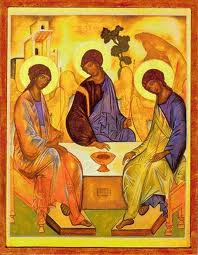
Have you Have you noticed how busy and distracted everyone is lately? Have you noticed how busy and distracted you’ve become lately? Busyness and distraction have become a way of life. How do we keep all the balls in the air – all the commitments in balance? How do you carve out time to pray when there are so many demands on your time?
Ronald Rolheiser, theologian and author once wrote “Distraction is normal in our culture. Contemplativeness, solitude and prayer are not.”
When I look at my own life, and listen to the lives of those around me, I am struck by how often I hear the phrase that has become a kind of mantra for many: “I’m so busy!” Perhaps the time for teaching – and practicing – the contemplative arts has never been more pertinent. On the other hand, ever since Eve and Adam left the Garden, it has been our sad refrain.
The Christian classic The Way of a Pilgrim chronicles the journey of an unnamed nineteenth-century Russian peasant. Following the tragic loss of his wife and livelihood, the pilgrim is propelled on a spiritual journey with nothing but a Bible, a prayer rope, and some dried bread, seeking an answer to his profound conundrum: how does one respond authentically to St. Paul’s prescription to “pray without ceasing”? (1 Thessalonians 5:17) His quest sets him wandering, searching for someone to teach him how to master such a seemingly impossible assignment.
At the very heart of The Way of the Pilgrim is the Jesus Prayer: “O Lord Jesus Christ, Son Of God, have mercy upon me a sinner!” Known in the Orthodox Church as “the prayer of the heart.” and dating back to at least the 4th century Egyptian desert, these simple words have been a mainstay for Orthodox Christians. This humble prayer is aided when prayed with a prayer rope in hand. First made by monks for their own use, prayer ropes were later adopted by those outside the monastery. While we may be tempted to think of prayer ropes as an Eastern version of the Rosary, they are actually quite different.
 Prayer ropes are usually made of wool, sheared from sheep – a reminder that we belong to Christ, the Good Shepherd. While they can be made in different colours, black – the colour of mourning – is most commonly used, for in prayer we mourn the sins which separate us from God and our neighbour. Some prayer ropes include a tassel which is customarily used to dry the tears shed in sorrow for one’s sins. For some, this tassel also symbolizes Heaven, which can only be found through the cross which, in the rope, precedes the tassel.
Prayer ropes are usually made of wool, sheared from sheep – a reminder that we belong to Christ, the Good Shepherd. While they can be made in different colours, black – the colour of mourning – is most commonly used, for in prayer we mourn the sins which separate us from God and our neighbour. Some prayer ropes include a tassel which is customarily used to dry the tears shed in sorrow for one’s sins. For some, this tassel also symbolizes Heaven, which can only be found through the cross which, in the rope, precedes the tassel.
The person praying says the Jesus Prayer for each knot on the rope. Often the rope is 33 knots long but they come in all different lengths. In The Way of the Pilgrim, the pilgrim said the prayer 2,000, then 6,000, then 12,000 times a day. Is 12,000 Jesus Prayers better than 2,000? It is not the quantity of the prayers that is important but rather the quality, the love with which the prayer is said and the faithfulness with which it is practiced. The pilgrim prayed much because that was his “heart’s desire.” Every prayer is an act of love, offered to the Author of Love, who waits expectantly for us and for our acceptance of his Love. Numbers have nothing to do with this kind of devotion or with a living relationship with Jesus.
When our hearts are restless and our minds wandering, the knots on the prayer rope can help us to focus on the words of the prayer. As our thumb and forefinger continuously move over the knots, our heart continuously cries out its plaintive words. Some years ago now I was gifted a prayer rope by Bishop Henry Hill who devoted much of his life to study and dialogue with the Orthodox community. Its soft, well-worn texture feels reassuring in my hands, and in a way that I do not fully understand, helps move the prayer from my lips to my heart.
Perhaps what is old can be new again. In our on-going quest to draw closer to Christ, I wonder whether the time has come for us to slow the pace, lose the distractions, leave the busyness behind and make a pilgrimage back to praying, without ceasing, the prayer of our hearts.
The Rev. Frances Drolet-Smith is Rector of St. Alban’s Anglican Church, Dartmouth N.S.
and Oblate of SSJD


